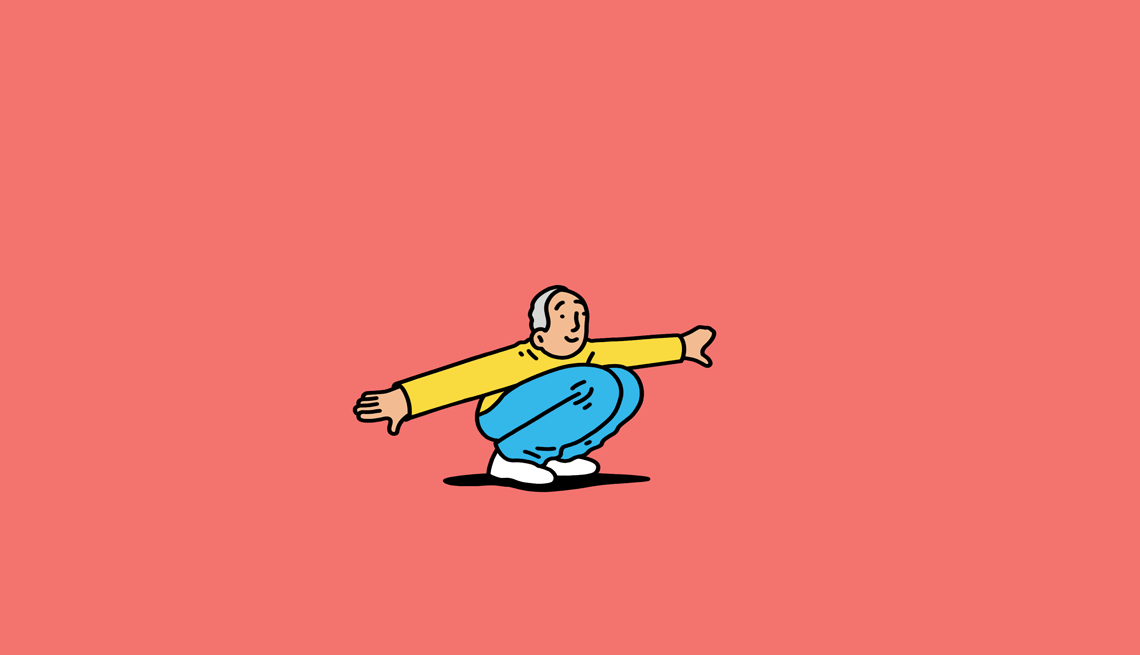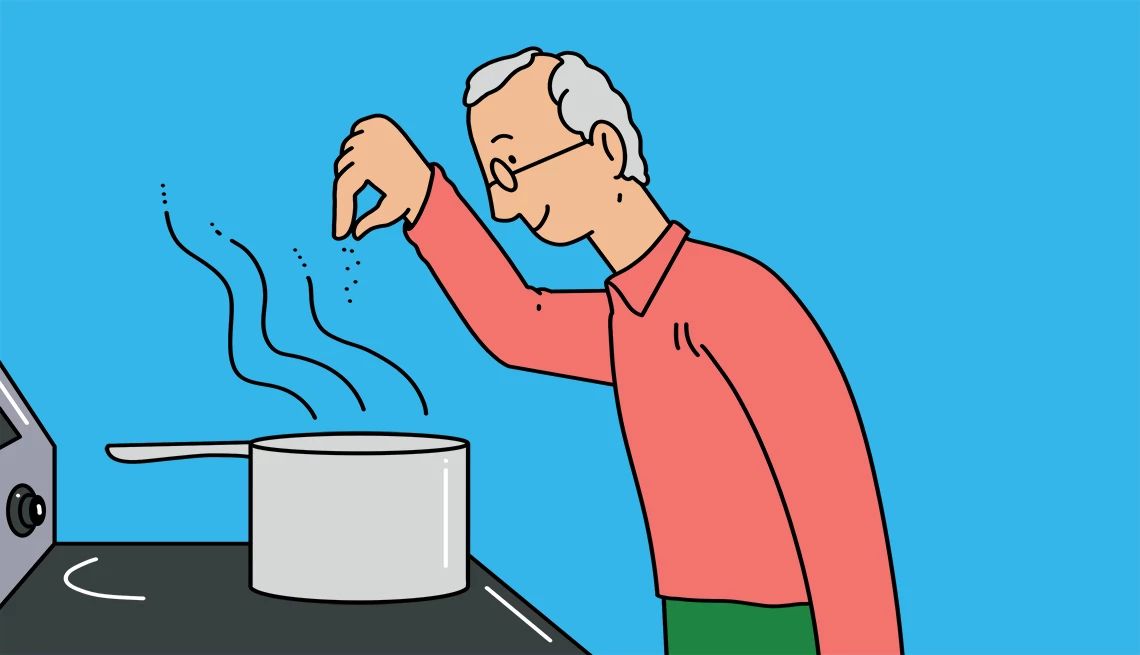AARP Hearing Center


Do you know how much salt is sneaking into your diet?
The Centers for Disease Control and Prevention’s recommended sodium maximum is 2,300 milligrams per day. The American Heart Association says we should eat even less — if the AHA had its way, we’d aim for 1,500 mg. But we ingest an average of 3,400 milligrams of daily sodium, according to the association. It reports that 97 percent of U.S. adults are completely unaware of how much sodium they consume.
Too much salt contributes to high blood pressure, a dangerous condition that becomes more common with age. More than half of adults age 40 to 59 and 75 percent of adults 60 and over have high blood pressure, according to the CDC.
Although your body needs a small amount of sodium to function, too much sodium has been linked not only to high blood pressure but also to an increased risk of heart failure, headaches, osteoporosis, high blood pressure, kidney stones, strokes and stomach cancer, all conditions more common with age. Excess sodium can also cause you to retain water, bloat and feel like you packed on extra pounds. It’s easy to overdo sodium-packed foods. They taste great going down, and the more salt you eat, the more you crave.
The good news? Research has shown that older adults who cut about a teaspoon of salt from their daily diet can lower their systolic blood pressure in just a week. Here are 25 ways to kick those salt cravings to the curb.
1. Cut back gradually
After reading that introduction, you may be inspired to make drastic changes, but when it comes to reducing your salt intake, slow and steady is the way to go. “Reducing salt doesn’t have to happen overnight. Gradually cut back, and your taste buds will adjust — soon, you won’t even miss it,” says Partha Nandi, a gastroenterologist and host of The Dr. Nandi Show.
To reduce cravings for the long haul, your palate needs to adjust to the taste of less salty food. “If you try cutting salt out completely right away, you’ll probably find that everything you eat seems kind of tasteless,” says Christine Byrne, a registered dietitian and the owner of Ruby Oak Nutrition in Raleigh, North Carolina. Scaling back gradually, she says, allows your taste buds time to adjust and get better at picking up the other flavors in the food you eat.
Worried you might miss all that salty flavor? In a report on goals for lowering sodium in the food supply, the Food and Drug Administration noted that people don’t often notice small changes in sodium, such as a reduction by 10 percent.
2. Track your salt consumption
A few handfuls of pretzels, a muffin from your favorite bakery, a serving of your favorite trail mix. As you go about your day, your sodium levels add up. Technology can help us pay more attention to what we eat. “Using an app, such as MyFitnessPal, can be helpful for tracking daily sodium intake,” says Rachel Ross, a registered dietitian at Tufts Medical Center. Enter your favorite foods into this app, and it will populate the nutritional content for you and keep track of nutrient markers such as calories and milligrams of sodium.
A small pilot study conducted by the European Society of Cardiology found that people who were educated on the risks of sodium and informed of the sodium content of their meals reduced their usual intake by 30 percent. “Additionally, this group experienced an increase in enjoyment of a low-salt diet, suggesting taste buds can adapt to enjoy low-sodium foods over time,” Ross says.


3. Cook more at home
Research shows that more than 70 percent of sodium comes from processed and restaurant foods, according to the AHA. Though it’s fun to eat out, a surefire way to reduce your salt intake is to cut back on how much you do it. “When you cook your own meals, you control the ingredients,” Nandi says. “My family and I practice the 90-10 rule: We make time to cook our food and control 90 percent of what goes into our bodies at home.” When following recipes at home, you can experiment by using less salt than the directions call for, swapping ingredients for lower sodium options and avoiding altogether recipes that may be too salty.
4. Look for sneaky salts on packaged foods
You check the back of a box of packaged food for “salt” in the ingredients list, which may also contain obvious terms such as “Himalayan sea salt,” “sea salt” or “kosher salt.” But sodium can hide under many different names, including monosodium glutamate (MSG), sodium bicarbonate, sodium nitrate, sodium bicarbonate, trisodium phosphate and disodium guanylate. If you see these on the packaging, pay attention to the overall sodium content to make sure the food is not too salty.
5. Limit high-sodium foods
“Avoid or limit salty foods — they will only increase the craving for salt,” says Julia Zumpano, a registered dietitian with the Cleveland Clinic Center for Human Nutrition. Common foods with high sodium levels include pizza, bread, cold cuts and cured meats, soups, burritos and tacos, cheese, baked goods, sausages, chips and grain-based dishes. Do your best to eat less of these foods and prioritize healthier swaps.
“There are food items like mixed nuts that have no added salt or lightly salted, crackers with unsalted tops, chips that are lightly salted,” says Amber Ingram, a registered dietitian at the Ohio State University Wexner Medical Center. If you want to snack, opt for those varieties instead of ones packed with sodium.
6. Don’t salt your food before you taste it
An estimated 11 percent of our daily sodium intake is from salt we add to our meals when we cook or eat. Instead of habitually salting your food before you eat it, try tasting your meal first. Instead of adding salt while cooking, cut back on the amount or wait until your meal is fully prepared, then see if you truly need it. “Taste before sprinkling — you may find you don’t need as much,” says Julia Shuff, a registered dietitian nutritionist and supervisor of coaching services at Teladoc Health. “When you do use salt, go slow and sprinkle gradually.”
7. Reduce your prepackaged food consumption
It’s not always easy to avoid processed foods, but cutting back can go a long way in helping to reduce your salt consumption. “Opt more often for whole unprocessed foods and snacks like fruits, vegetables, etc., and skip the prepackaged snack foods that are often ultra-processed and loaded with extra fat, salt and sugar,” Ingram says. You’re probably not getting the World Health Organization’s recommended amount of at least five portions of fruits and vegetables per day. The latest CDC data, from 2019, showed that only 10 percent of American adults do. Fill the gaps in your diet by replacing salty processed foods with the things you should eat for optimal health.
8. Drink plenty of water
Next time you crave something salty, ask yourself when was the last time you drank water. “Often, what is perceived as a salt craving can actually be your body signaling dehydration,” says Lauren Manaker, a registered dietitian-nutritionist in Charleston, South Carolina. She suggests drinking H2O regularly throughout the day, aiming for at least eight glasses. You may need more.
Research from the National Academy of Medicine says women over 50 should aim for 91 ounces per day and men of the same age may need as much as 125 daily ounces. Drinking a glass of water may be enough for you to say no to those potato chips on your mind! You can also snack on high-water-content foods, such as cucumber, celery, tomatoes, spinach and watermelon.


































































You Might Also Like
25 Great Ways to Get a Flatter Stomach
Tips on how to lose belly fat and get a tighter tummyTry These Tips for Living a Healthier Life
Small changes can add up to big mental and physical results
Wake Up More Refreshed With Our Smart Guide to Sleep
43 tips to help you fight those restless, endless nights and get the slumber you need
Recommended for You